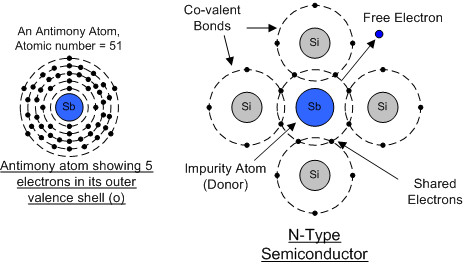N-type Semiconductor Basics
In order for our silicon crystal to conduct electricity, we are required to introduce an impurity atom like Antimony, Arsenic, or Phosphorus into the crystalline structure making it extrinsic (the impurities are added). These atoms contain 5 outer electrons in their outermost co-valent bond to share with the other atoms and are commonly called as "Pentavalent" impurities. This allows 4 of the 5 electrons to bond with its neighbouring silicon atoms leaving one "free electron" to move when an electrical voltage is applied (electron flow). As each impurity atom "donates" one electron, pentavalent atoms are usually called as "donors".
Antimony (symbol Sb) is used as a pentavalent additive frequently as it has 51 electrons arranged in the 5 shells around nucleus. The resulting semiconductor material has the excess of current-carrying electrons, each with the negative charge, and is thus referred to as "N-type" material with the electrons called as "Majority Carriers" and the resultant holes "Minority Carriers". Then the semiconductor material is N-type when the donor density of it is greater than the acceptor density of it. Thus, a N-type semiconductor has more electrons than the holes.

The diagram drawn above shows the structure and lattice of donor impurity atom Antimony.
Email based Electronics Devices and circuits assignment help - homework help at Expertsmind
Are you searching Electronics Engineering assignment help expert for help with N-type Semiconductor Basics questions? N-type Semiconductor Basics topic is not easier to learn without any external help? We at www.expertsmind.com offers free lecture notes for Electronics Devices and circuits assignment help and Electronics Devices and circuits homework help. Live tutors are available 24x7 hours for helping students in their N-type Semiconductor Basics related problems. We provide step by step N-type Semiconductor Basics question's answers with 100% plagiarism free content. We prepare quality content and notes for N-type Semiconductor Basics topic under Electronics Devices and circuits theory and study material. These are avail for subscribed users and they can get advantages anytime.
Why Expertsmind for assignment help
- Higher degree holder and experienced experts network
- Punctuality and responsibility of work
- Quality solution with 100% plagiarism free answers
- Time on Delivery
- Privacy of information and details
- Excellence in solving electronics engineering questions in excels and word format.
- Best tutoring assistance 24x7 hours